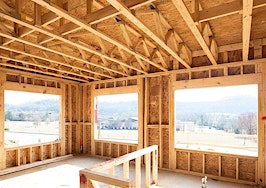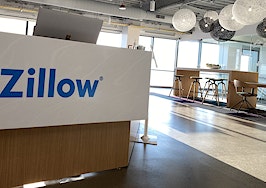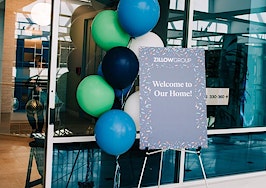Online real estate giant Zillow managed to buck the economic crisis of the coronavirus pandemic during this year’s second quarter, raking in better-than-expected revenue thanks to “powerful tailwinds” in the industry and the growth of iBuying.
In an earnings report Thursday, the company revealed that between April and June it brought in $768 million in revenue, which was up 28 percent compared to the second quarter of 2019. Analysts had only expected Zillow to report $606.02 million in revenue.
Zillow’s net loss in the second quarter was $84 million, up slightly from just under $72 million a year ago but down significantly from $163 million last quarter.
The company’s statement notes that the quarter’s revenue growth was “driven primarily by a continued increase in Zillow Offers resale volume.”

Rich Barton
Company co-founder and CEO Rich Barton responded optimistically to the earnings Thursday, saying in a statement that they were “even better than we had hoped, and firm up our belief that powerful tailwinds in both real estate and technology are rapidly converging, with Zillow at the nexus.”
During a call with investors, Barton added that Zillow “faced down fear and uncertainty” and said “the second quarter was one for our history book.”
Probably the brightest spot for the company this quarter was its Homes segment, which includes iBuyer Zillow Offers. The Home segment alone brought in $454.3 million during the second quarter, beating Zillow’s own estimate that the segment would bring in a maximum of $350 million. The earnings report further reveals that during the quarter Zillow bought 86 homes, sold 1,437 and ended up with 440 in inventory — the lowest number since the third quarter of 2018.
In retrospect, the relative strength of Zillow’s iBuying makes sense given the way the pandemic has played out. Though there were concerns early on about a slowdown in the housing market, in reality inventory ended up being extraordinarily low while demand stayed high. Those conditions naturally favor anyone who happens to have a large number of homes stockpiled and ready to sell.
However, Zillow’s dwindling inventory of houses could become a problem if market conditions hold steady. In the second quarter Zillow sold vastly more homes than it bought, and with only 440 remaining it may lack the potential to fully repeat its recent success. High demand and low inventory also means homesellers generally have less incentive to sell to an iBuyer, meaning replenishing inventory could be a struggle.
Zillow’s own outlook appears to reflect these conditions. In its report Thursday, it projected earning only between $140 million and $160 million from its Homes segment next quarter. The company has beaten its own outlooks before, but those numbers are still down considerably compared to the second quarter.

Allen Parker
Chief Financial Officer Allen Parker further said during the call with investors that the company’s inventory balance would likely contribute to lower revenue for the segment next quarter.
Both Parker and Barton additionally compared Zillow Offers to a factory Thursday, saying that pausing “production” — which the company effectively did when it halted iBuying in March — inevitably leads to less inventory.
“Of course pausing the factory for eight weeks or so is going to cause an air gap in product,” Barton said.
Barton also observed that inventory generally in the market has been “stubborn” despite good prices for homes.
Nevertheless he remained optimistic, arguing that iBuying may appeal to consumers right now because it offers convenience, time certainty and less exposure to the pandemic.
“Those feel like good things in the midst of a health crisis,” he said. “And we’re seeing that play out.”
Beyond iBuying, Zillow’s report Thursday provided a number of other strong data points as well. Among other things, Zillow set a new traffic record during the quarter with 2.5 billion visits to its website. That breaks down to 218 million average monthly unique users, the report explains, and in June represented a year-over-year increase of 32 percent.
Zillow also has $3.5 billion in cash, which it said in its report put it on “strong financial footing” and is the highest balance in company history.
Barton added in his statement that he believes “we are at the dawn of a Great Reshuffling, as COVID and work-from-home policies are inspiring people to rethink their homes and consider moving.”
Zillow’s stock spiked Thursday following the release of the report, jumping from a closing price of $71.57 per share at the closing of the market to nearly $80 in after hours trading.

Credit: Google
Zillow previously reported earnings in May, when the company revealed that it had raked in $1.1 billion during the first three months of 2020. That beat analysts’ expectations at the time and more than doubled what the company earned one year prior.
However, while the first quarter of 2020 included the beginning of the coronavirus pandemic in the U.S., it wasn’t until now that the full impact of the outbreak on the company has finally begun coming into focus. And while the pandemic clearly had an impact — revenue was down in the second quarter compared to the first — the higher-than-expected revenue, the strong traffic numbers and other data points suggest the company is faring quite well amid uncertain times.
Overall, the pandemic has been something of a wild ride for Zillow. Early on, the firm’s own data showed that the outbreak doused what was poised to be a hot spring for homebuying. In addition to suspending Zillow Offers, the company responded to the crisis by covering some costs associated with its Premier Agent program for real estate professionals, among other things.
That move contributed to lower revenues during the second quarter from the Premier Agent program. According to the earnings report Thursday, the program brought in $192 million, down 17 percent year-over-year — though the company expects growth in the program next quarter.
In any case, by the end of April, Zillow was also seeing rising web traffic and growing consumer interest in real estate. And by the beginning of August, it had restarted Zillow Offers in all of the program’s pre-pandemic markets.
The moves hinted at a bullishness about the market that is in line with anecdotal tales from agents across the country who have said they were busier than ever in recent weeks.
Zillow also reported strong earnings in February, when revenue jumped 158 percent year-over-year, beating expectations.
During Thursday’s investor call, Barton acknowledged that amid a health crisis, protests and other world events the future remains uncertain. But he also argued that the pandemic is ultimately accelerating existing trends such as the adoption of new technology, and Zillow should benefit as a result.
“We believe we are the outsized beneficiary of this tailwind,” he said.
Update: This post was updated after publication with additional information from Zillow’s earnings report and a phone call company executives held with investors.













